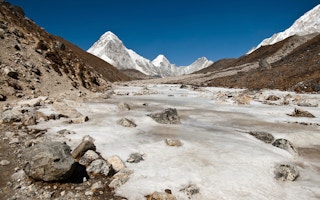In our collective imagination, the Himalayas – the roof of the world – are an archetype: glistening white, distant, even otherworldly. Climbing them is proof of humanity’s daring, courage, and drive – a spirit recently captured in 14 Peaks: Nothing Is Impossible, a Netflix documentary chronicling one mountaineer’s attempt to summit the world’s highest peaks in seven months. And yet, despite rising 6,993 metres (nearly 23,000 feet) above sea level, the summit of Mount Machapuchare in central Nepal resembled a black rock pyramid this winter, devoid of ice and snow. Glaciers near Mount Everest have turned into large lakes.
More than a tourist attraction or a place for high adventure, the Himalayas play a crucial role in regulating the planet’s climate. They are also the source of fresh water for billions of people and for the region’s rich (though increasingly degraded) ecosystems. As a result, rising temperatures and glacial melt are having far-reaching consequences that already pose grave risks to humanity.
The Tibetan Plateau is at the center of High Mountain Asia, an area known as the Third Pole because it is Earth’s third largest store of frozen water, after Antarctica and the Arctic. The region has about 15,000 glaciers that cover almost 100,000 square kilometres of High Mountain Asia, containing 3,000-4,700 cubic kilometres of ice. The glaciers supply the Amu Darya, Brahmaputra, Ganges, Indus, Irrawaddy, Mekong, Salween, Tarim, Yangtze, and Yellow river basins.
The Hindu Kush Himalayas stretch across 3,500 kilometres and span India, Nepal, China, Bhutan, Pakistan, Afghanistan, Bangladesh, and Myanmar, all of which have sought to subject the mountains, including their water, air, and ecosystems, to their sovereign control. As the climate crisis makes monsoons more erratic, dries springs, lowers the water table, and threatens the food supply, the lack of cooperation and coordination among these states augurs trouble – and represents a global policy failure that starkly demonstrates the absence of credible international leadership.
In 2020, a group of professors, researchers, students, and alumni of New York University Abu Dhabi (NYUAD) and other universities launched the Himalayan Water Project to highlight the urgency of the crisis and the paucity of interdisciplinary approaches needed to help countries prepare for the worst. But encouraging cooperation has not been easy in a region where intense rivalries, territorial disputes, and suspicion are rife, and China’s growing economic and political clout has stoked hostility.
Calls for the resurrection of a bipolar world order, in which democracies are decoupled from autocracies, further undermine the cooperation that interdependence demands. To the extent that this mindset prevails, it will be impossible for policymakers to understand and address the multifaceted climate-related hazards stemming from the crisis in the Himalayas.
The International Center for Integrated Mountain Development in Kathmandu, which includes eight Himalayan countries, is currently the only regional organisation trying to grapple with the complexity of the crisis. But the initiative focuses heavily on the exchange of data, as if only scientific knowledge were “neutral” enough to flow between member states. Yet even this type of exchange can be thwarted by regional disputes. It is, moreover, unimaginative to constrain policy to the scientific realm, especially in an era when so many governments and international organisations are touting their commitment to inclusion, equity, and different forms of knowledge production.
With the exception of the Indus Waters Treaty between India and Pakistan, there are no genuine regional efforts to cooperate in the management of riparian resources. In fact, states continue to invest in waterway infrastructure that obstructs and redirects the natural flow of rivers that gives life to ecosystems and people. Engineers shape policy in the belief that humans can dominate and control the environment, an outlook that may seem to produce quantifiable benefits in the short term but is destructive in the medium and long term.
This January, our two NYUAD undergraduate classes traveled to Kathmandu to learn about the geopolitical and ecological implications of these melting mountains. The students participated in a conference where experts from a variety of fields addressed a broad range of issues, from seismic activity and water agreements to public policies and the disposition of cultural artifacts. The key takeaway was that the multifaceted nature of the challenge in the region should not impede action, but instead spur the development of a holistic approach.
Whenever the smog cleared and the peaks revealed themselves, we felt a renewed sense of awe. The Himalayas are both majestic and fragile, eroding and growing as the tectonic plate on which the Indian subcontinent sits pushes under the softer Asian continent. The mountains interact with the sky above and the rivers below, and any changes to this delicate balance could affect the lives and livelihoods of billions of people.
Yet the glaciers are rapidly melting – this couldn’t be clearer. Members of our research team who went up to 5,800 meters below Mount Everest in mid-January saw bare rock instead of snow, and melt pools where there used to be moving ice towers.
Climate change is accelerating, and we need policies that will help the countries of the Himalayan watershed adapt. The current reshuffling of the global order ignores one of the most critical threats to stability. The so-called great powers must comprehend what is at stake and act decisively, or else stop pretending to be leaders on global climate issues.
Sophia Kalantzakos is professor of environmental studies and public policy at New York University, Abu Dhabi. She is the founding head of the Geopolitics and Ecology of Himalayan Water project.
Kunda Dixit is a visiting faculty member at New York University, Abu Dhabi. He is a publisher at the Nepali Times in Kathmandu and author of Dateline Earth: Journalism as if the Planet Mattered (Inter Press Service, 1997).
© Project Syndicate 1995–2023












